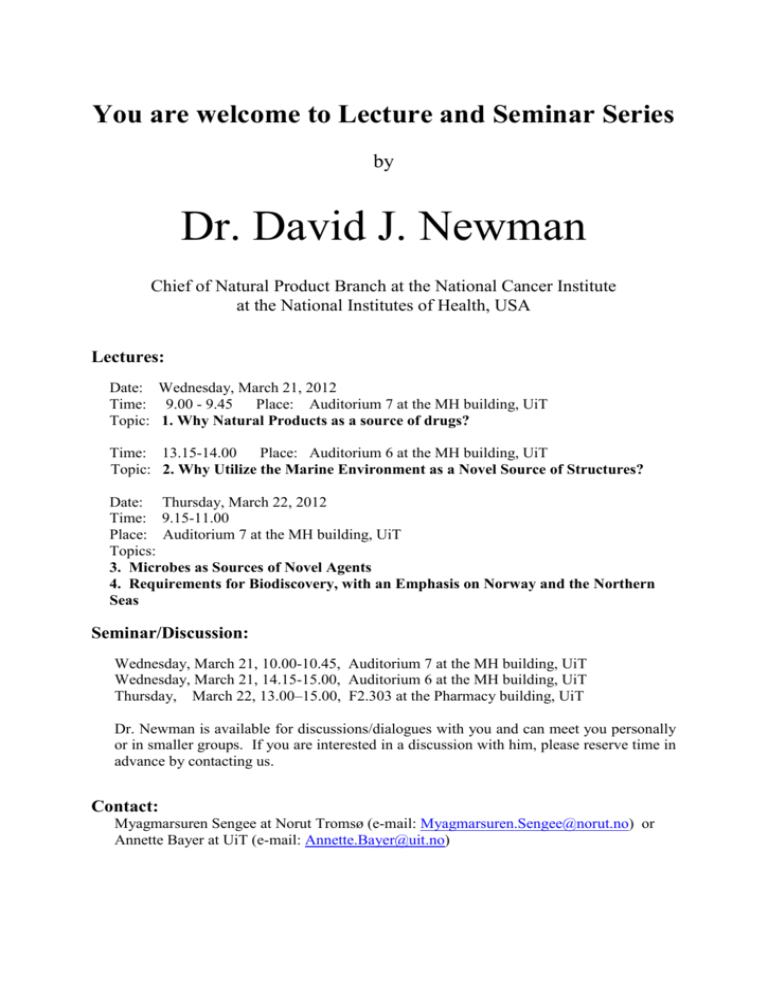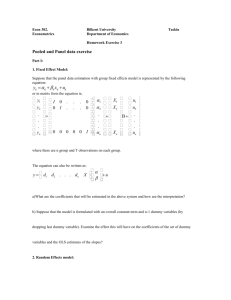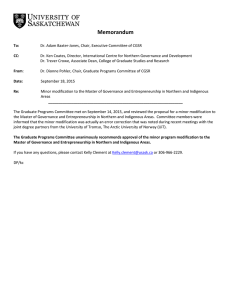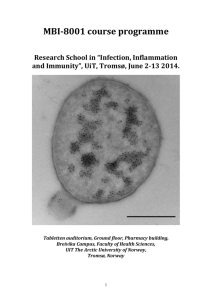A brief introduction of David J. Newman
advertisement

You are welcome to Lecture and Seminar Series by Dr. David J. Newman Chief of Natural Product Branch at the National Cancer Institute at the National Institutes of Health, USA Lectures: Date: Wednesday, March 21, 2012 Time: 9.00 - 9.45 Place: Auditorium 7 at the MH building, UiT Topic: 1. Why Natural Products as a source of drugs? Time: 13.15-14.00 Place: Auditorium 6 at the MH building, UiT Topic: 2. Why Utilize the Marine Environment as a Novel Source of Structures? Date: Thursday, March 22, 2012 Time: 9.15-11.00 Place: Auditorium 7 at the MH building, UiT Topics: 3. Microbes as Sources of Novel Agents 4. Requirements for Biodiscovery, with an Emphasis on Norway and the Northern Seas Seminar/Discussion: Wednesday, March 21, 10.00-10.45, Auditorium 7 at the MH building, UiT Wednesday, March 21, 14.15-15.00, Auditorium 6 at the MH building, UiT Thursday, March 22, 13.00–15.00, F2.303 at the Pharmacy building, UiT Dr. Newman is available for discussions/dialogues with you and can meet you personally or in smaller groups. If you are interested in a discussion with him, please reserve time in advance by contacting us. Contact: Myagmarsuren Sengee at Norut Tromsø (e-mail: Myagmarsuren.Sengee@norut.no) or Annette Bayer at UiT (e-mail: Annette.Bayer@uit.no) ABSTRACT OF THE LECTURES: The content and duration of the last three lectures can be modified with a variation on your request. Please contact us as soon as possible if you want a variation to be emphasized. 1. Why Natural Products as a source of drugs? Although “Big Pharma” has in general, moved away from Natural Products as a source of drug leads or drugs themselves, the published record demonstrates that over the last 30 years NP structures or modified structures are still major sources of drugs against a variety of diseases. This seminar will cover some history but will demonstrate how even in the “age of combi-chem”, NP structures and the “Chemical DNA of those structures” is still utilized in drug discovery. 2. Why Utilize the Marine Environment as a Novel Source of Structures? The marine environment is unique amongst the globe’s niches in that it has temperature variations from -2 oC to greater than + 350 oC in the areas of the deep smokers, plus pressure differentials that go to >1100 Bar in areas such as the Marianas Trench. Under such conditions, marine invertebrates have flourished (at least down to 300 - 400 metres or greater) and have developed what can best be described as “chemical warfare agents” as a means of protection. This talk will cover some of the classes of agents that have been isolated and purified and then led to novel molecules that are in or approaching clinical trials in a variety of diseases relevant to man. In a number of cases, the structures resemble terrestrial compounds, but iwith others, none like them have been reported. A variation can be: There will be a variant of this talk that covers the probable “true” source(s) of the compounds covered, which can be a standalone version leading into a more general discussion of the role of genomics in compound discovery. 3. Microbes as Sources of Novel Agents Though some scientists tend to think that the “golden age of microbes” has passed due to the very significant drop in antibiotic discovery programs, this talk is designed to demonstrate that this is not the case, and that particularly in the marine environment but also in the terrestrial environment, the interplay of microbes with different kingdoms (even domains) is a source of very interesting molecules. With the advent of very cheap genomic sequence data and fairly soon a complete DNA sequence will be close to 17,000 Kroner ($3000 US) . When this information is coupled to datamining techniques, the ability to find “cryptic biosynthetic clusters” will dramatically increase. Coupling such data to methods of production in heterologous hosts should provide access to previously unknown molecules. Examples of where parts of this have been done or where some but not all of the necessary information is available will be given, covering both marine and terrestrial sources. Will involve commentary on extremophiles (hypersaline, anaerobic, thermophilic and hyper themophiles) with emphasis on where they might be “lurking” in Norwegian waters and related areas. A variation can be: The activation of previously unknown “cryptic biosynthetic clusters” by mimicking the interactions that may occur between different domains of life, but at the microfloral level. This will cover the production of what may be previously unrecognized metabolites following their increased production, or molecules that may be the product of “switch on” of unrecognized clusters. This talk is designed to show that such interactions can occur across all domains. These will also cover genomics and what has been done so far and what is quite probably what we will find in the near future. 4. Requirements for Biodiscovery, with an Emphasis on Norway and the Northern Seas This talk will involve discussion of biorepositories with hopefully realistic ideas as to the “value” of such operations, not just monetary but more importantly, knowledge that will aid in future Norwegian enterprises. There will also be some ideas as to the personnel that may be necessary to undertake such tasks, together with an idea as to their training. In addition, some ideas as to the timing involved and a realistic look at the numbers involved both of compounds/extracts and costs for development of drugs. There will also be some suggestions as to groups with whom one can interact, not limited to Norway or the US but in Europe, Russia and the Far East. A variation can be: Can split this into various aspects depending upon the audience. A brief introduction of David J. Newman Dr. David Newman received MSc degree in Organic Chemistry from the University of Liverpool, UK in 1963 and completed his D.Phil degree in Microbial Chemistry from the University of Sussex, UK in 1968. He then moved to USA and spent a couple of years as a postdoctoral researcher at Prof. H.D. Peck’s research group at the University of Georgia, Athens. From 1970 to 1991, he worked as senior and principal investigator at several leading biotechnological and pharmaceutical companies in USA such as Smith Kline & French Laboratories etc. Since 1991 he has been working as scientist and chief at Natural Products Branch, National Cancer Institute, Frederick, Maryland in addition to his adjunct position as full professor at University of Maryland between 2001 and 2005. He also earned MSc degree in Information Science from Drexel University, Philadelphia in 1977. His research interests are natural products as sources of novel pharmacophores with an emphasis on marine and microbial sources; delivery of natural product based toxins to cellular targets; the biochemistry of metals, particularly in relation to bioenergetics in prokaryotes and lower eukaryotes; history of drug discovery; and modern information technologies. He is author of more than 144 scientific papers and book chapters and has 22 patents to his credit.











